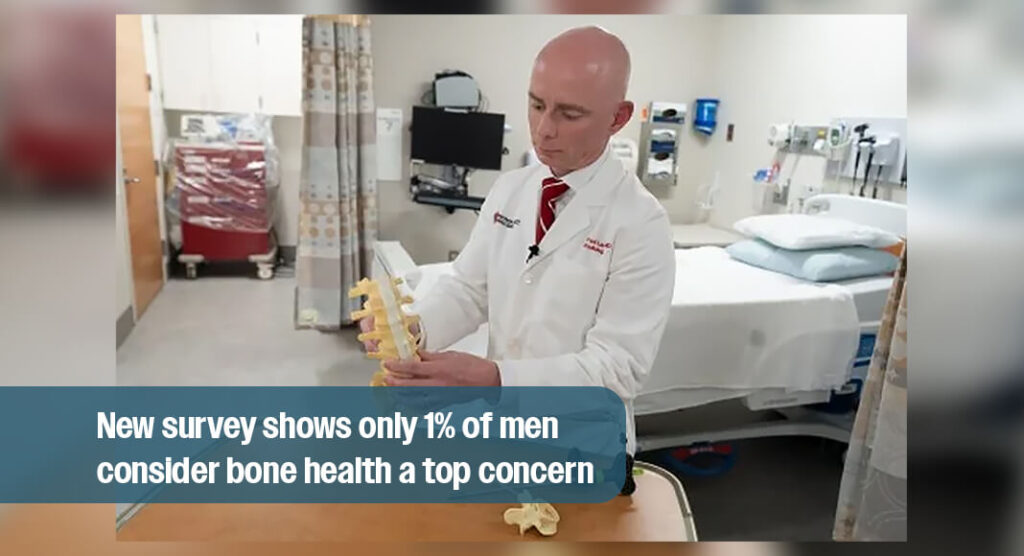
Mega Doctor News
By Ohio State University Wexner Medical Center
Newswise — COLUMBUS, Ohio – Weak bones can have deadly consequences. Women often get bone density tests to screen for osteoporosis, yet many men don’t even realize they are at risk until they suffer a major fracture.
June is Men’s Health Awareness Month, with a focus on raising awareness about osteoporosis in men.

A new survey commissioned by The Ohio State University Wexner Medical Center among U.S. adults finds that only 1% of men are concerned about bone density.
This concerns Paul Lewis, MD, an interventional radiologist at Ohio State Wexner Medical Center.
“It’s a silent disease, and it’s silent until it makes some noise, and how it makes noise is with a fracture,” said Lewis, who often treats patients with spinal and pelvic fractures.
The National Spine Health Foundation estimates that 2 million men have osteoporosis, while another 16 million men have low bone mass known as osteopenia.
The Ohio State survey found cancer (32%) is the number one concern when it comes to men’s health, followed closely by heart disease (30%). Other top concerns include obesity (18%) and sexual health (8%).
With so many other pressing medical concerns, men often are surprised to learn they have osteoporosis. The disease, which means porous bones, causes a gradual loss of bone density and strength, which puts individuals at higher risk for broken bones, even from minor falls.
A fracture for an older adult can be deadly, which is why prevention is key, Lewis said.
“If you don’t participate in resistance training as early as 30 years old, 40 years old, you can start losing up to 3% of your bone mass per year,” said Lewis, who also is an associate professor in The Ohio State University College of Medicine.
It is possible to build back bone density with exercise, nutrition and by not smoking or drinking alcohol excessively.
“If we maintain more active lifestyles longer in life, we do anticipate less bone loss,” Lewis said.
In addition, once someone develops spinal fractures due to osteoporosis, interventional radiologists can treat them with kyphoplasty or vertebroplasty procedures.
During kyphoplasty, a small balloon is inserted into the fractured vertebra and inflated to create a cavity. Bone cement (a synthetic material made of polymethyl methacrylate) is then injected into the cavity to stabilize the fracture and treat the pain.
Vertebroplasty involves injecting bone cement directly into the fractured vertebra without using a balloon, providing immediate stabilization and pain relief.
“Both procedures aim to relieve pain, restore vertebral height and enhance spinal stability, allowing patients to regain function and mobility. They are performed under a twilight sedation and fluoroscopic imaging guidance. Patients experience minimal downtime and faster recovery compared to open surgery,” Lewis said.
The loss of the hormone testosterone also contributes to weak bones, which is why men need to be more mindful of osteoporosis as they age. Lewis recommends that men should start this conversation with their doctor at age 30, giving themselves plenty of time to prevent weak and porous bones.
Lewis explains the consequences of not treating osteoporosis early.
“We’re treating more than just a fracture; we’re treating the whole person,” Lewis said. “They’ll be more active and they’ll be more independent. They won’t be as isolated because of this pain and staying at home or staying in a chair.”
Survey Methodology
This study was conducted by SSRS on its Opinion Panel Omnibus platform. The SSRS Opinion Panel Omnibus is a national, twice-per-month, probability-based survey. Data collection was conducted from May 2 – May 5, 2025, among a sample of 1,008 respondents. The survey was conducted via web (n=978) and telephone (n=30) and administered in English. The margin of error for total respondents is +/-3.6 percentage points at the 95% confidence level. All SSRS Opinion Panel Omnibus data are weighted to represent the target population of U.S. adults ages 18 or older.









